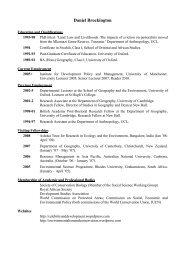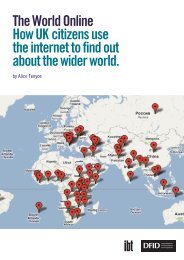World
Viewing the world - Full report
Viewing the world - Full report
- No tags were found...
Create successful ePaper yourself
Turn your PDF publications into a flip-book with our unique Google optimized e-Paper software.
its immediacy but its weakness could be that it issuperficial. Television in general was not seen as offeringenough insights into the outside world. While describedas a ‘window on the world’ there was agreement withinmost of the groups that in-depth contextualisation ofsituations did not really exist. Respondents said thattelevision coverage enhanced notions which they heldabout certain problems being ‘too far away’ to beconcerned about. Another criticism was that the focus bythe media on disasters in the developing world led to aconstant flow of images in which one catastrophefollowed another, but without any sense of what hadhappened before or after each one. There was a desire tohave stories followed up.A number of respondents referred to the usefulnessof Newsround as a way of getting simple backgroundinformation on issues. This programme was seen asoffering the viewer an explanation that did not assumebackground knowledge of an issue. The ‘5 points’ bulletsystem of C5 News was also commented on favourably.There was much discussion in the groups about whytelevision news offered very limited explanations aboutevents in the developing world. The short length of somebulletins was pointed to as a possible issue and these werecompared with the longer and more in-depth coverage ofprogrammes such as Channel 4 News and Newsnight. Theseprogrammes are however shown at relative marginaltimes in the television schedule and only a minority ofpeople watched them.Some in the groups commented on the strong focusin news programmes on stories from Britain andAmerica, which lead to viewers not getting a ‘proper’ lookat the world. Some of the groups also identified whatmight be termed the ‘half-way through problem’: whenjournalists covering a long running story tend to assumethat their audience has watched the full sequence ofreports, and so they do not need to repeat backgroundissues mentioned in earlier reports. But in practiceaudiences come into stories at different points in thesequence, and may have difficulty following the nextseries of reports. Questions were also raised in the groupdiscussions about the understanding of majorinstitutions such as the International Monetary Fundand the <strong>World</strong> Bank which are frequently referred to innews bulletins. We found that there was almost noknowledge at all about what these institutions were orhow they operated.DEBT RELIEFIn the initial groups none of the respondents knewanything about the campaign to cancel debt indeveloping countries, and claimed to have seen nothingabout it on television. In later groups this changed as anumber of programmes and news items appeared whichcould then be discussed. On the whole the attitude of allthe respondents was that they really did not understandwhat the issue was about, but they agreed that writing offdebt was a good idea. There was very little discussionabout the underlying causes of the debt problem,indicating a lack of knowledge of the issues involved andof the basis of international economics.It was also felt in the groups that there needed to bemore discussion (particularly within varied mediaformats) of the implications of writing off debt. Thisraises very important questions about how the currentdebate on debt relief is reported. For example, on BBC 1recently it was reported that ‘cancelling the debt will costBritish tax payers £640 million over 20 years’. (BBC11800, 21/12/99). To a great many people with littleknowledge of how the national economy or internationalfinance works this may sound like a significant personalcost. But another way of expressing this amount mighthave been that it will cost each person in Britain around50 pence per year for the next 20 years: not a great deal ofmoney when spread over a long time period.DOCUMENTARIESThe majority of respondents believed that documentariescould be both informative and interesting but thatthere were not many of these programmes. Dislike ofdocumentaries centred on how ‘dry’ or ‘boring’ theirpresentation was, and discussion centred on howformats could be altered to make programmes morewatchable. Some suggestions were offered such asmixing political situations with the reality of thatsituation for ‘normal’ people.HOLIDAY/TRAVEL, WILDLIFE AND COOKERYRespondents commented that mainstream holidayprogrammes focused on holiday complexes and safaris,selling a ‘sanitised’ version of reality where you couldactually be almost anywhere in the world. Somerespondents did find appeal in travel programmes whichwere perceived as offering a more realistic notion of whatcountries were like. These types of programmes were seento be informative because they offered insights into boththe cultural and political backgrounds of countriesvisited.Most respondents liked wildlife programmes, andthere was a positive response to programmes which showhow the animals and humans impact one another, andwhich feature local human communities.12 DFID – July 2000





